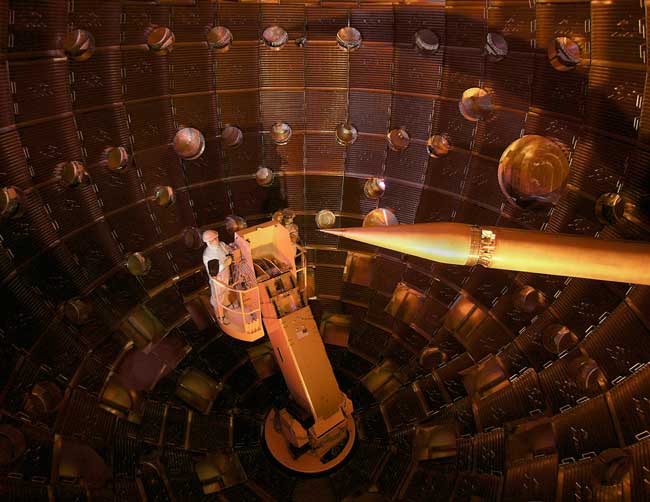Powerful Ideas: Fusing Atoms Just Might Work

This occasional series looks at powerful ideas — some existing, some futuristic — for fueling and electrifying modern life.
Solar power captures sunlight to create renewable energy, but recreating the sun on Earth holds even greater energy potential. Nuclear fusion — the power source inside the sun — will be attempted in new and soon-to-be-built facilities around the world.
"Fusion is a carbon-free and a virtually limitless supply of energy," said Ed Moses, project manager for the Department of Energy's recently commissioned National Ignition Facility (NIF) in Livermore, Calif.
The primary fuel for nuclear fusion is hydrogen, which is abundant in water. When two hydrogen nuclei are fused together to form helium, copious amounts of energy are released.
Pound for pound, nothing beats fusion for generating energy. Roughly 0.4 percent of the mass of the reactants is converted into energy during a nuclear fusion reaction. This is about a million times more efficient than any chemical reaction, and about 4 times that of a nuclear fission reaction.
A year's worth of operation at a 1 gigawatt power plant would only require a quarter ton of fusion fuel, whereas it would require 3 million tons of coal. Although fusion generates some radioactive waste, it is less dangerous than what is left-over from fission reactors.
Nuclear fusion power plants are still decades away, and a wide field of technological options remain — including lasers, magnetic fields and even collapsing bubbles.
Get the world’s most fascinating discoveries delivered straight to your inbox.
Laser punch
Humans have in fact created nuclear fusion in the H-bomb. The trouble is containing that energy in a sustainable fashion that can generate electricity.
One idea is to use multiple lasers to implode a millimeter-sized pellet filled with hydrogen fuel. This "inertial confinement" would heat the core of the pellet to more than 100 million degrees Fahrenheit, in which case the hydrogen would ignite, setting off a chain reaction that releases more energy than the lasers provide.
At least that's the idea. Ignition has not yet been achieved, but many believe it will happen at NIF. The $3.5 billion facility, which turned on last month, houses the largest laser in the world in a building the size of three football fields.
Although NIF's primary goal is to do nuclear weapon simulations, it will also be studying nuclear power generation. Moses expects they will attain ignition in the next two years.
"A fusion energy pilot plant could be on line in the 2020 time frame, followed by a demonstration commercial power plant in 2030," Moses told LiveScience.
Magnetic shields up
The main competitor in the fusion game is called magnetic confinement. It involves heating ionized hydrogen gas (called plasma) to hundreds of millions of degrees Fahrenheit, at which point it begins to burn on its own. The temperature is high enough to melt through metal, but strong magnetic fields keep the plasma away from the vessel walls.
Moses compares magnetic fusion to a steam turbine, in which fuel is burned continuously to generate useful work. In contrast, laser fusion is more like an internal combustion engine, where a series of micro-explosions, or sparks, drives the system.
"Both techniques may in the future provide a limitless supply of clean fusion energy," Moses said.
The biggest magnet-based project is the International Thermonuclear Experimental Reactor (ITER), which has begun construction in southern France. Once completed in 10 year's time, ITER will attempt to create 500 megawatts of fusion power for several-minute-long stretches. However, this is still just a demonstration — no electricity will be generated by this facility.
The estimated price tag for ITER is $10 billion, but that is likely to go up as the project moves forward. U.S. contributions to the multi-nation project had been put on hold last year, but funding has been partially reinstated by the new Congress.
The "also running"
There are a number of dark horses vying to capture the sun's power. One uses electric fields to collide particles in the center of a cavity, while another uses massive bursts of electricity to superheat a miniature oven.
However, the most well-known alternative is "cold fusion." In 1989, scientists claimed they had made fusion reactions in water at room temperature, simply by adding some electric fields. Attempts to reproduce the results failed.
Cold fusion never died, though. It has been rebranded low energy nuclear reaction (LENR), and continues to receive public and private funding. Recently, a group claimed to have seen fusion-generated particles in an LENR experiment.
Another controversial technology is sonofusion, in which bubbles are rapidly squeezed by sound waves. A few years ago, a group claimed that a possible sign of fusion had been detected from just such an experiment. However, the bubble burst when allegations of research misconduct later surfaced.
- Readers Pick: Top 10 Alternative Energy Bets
- New Hope for Controversial 'Cold Fusion' Power Source
- Video: All About Solar Power
{{ video="081210_OrchardSun2" title="All About Solar Power" caption="How much of the Sun's energy can be harvested? Is solar truly the most sustainable power source? Visit the Googleplex, home of Google.com, to find out. Credit: IMAGINOVA STUDIOS / Dave Brody" }}
 Live Science Plus
Live Science Plus






